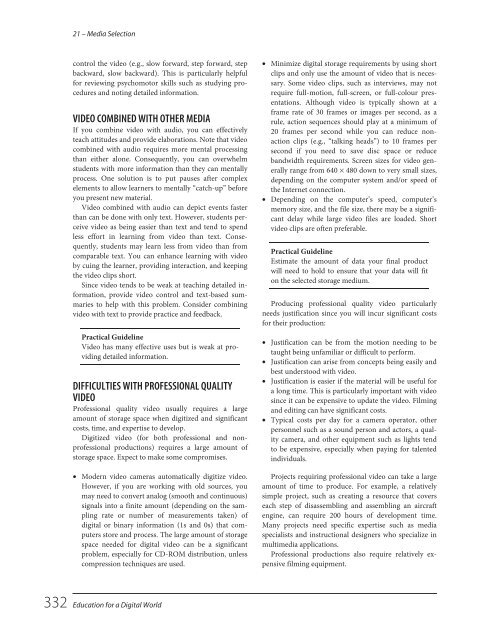Education for a Digital World Advice, Guidelines and Effective Practice from Around Globe, 2008a
Education for a Digital World Advice, Guidelines and Effective Practice from Around Globe, 2008a
Education for a Digital World Advice, Guidelines and Effective Practice from Around Globe, 2008a
You also want an ePaper? Increase the reach of your titles
YUMPU automatically turns print PDFs into web optimized ePapers that Google loves.
21 – Media Selection<br />
control the video (e.g., slow <strong>for</strong>ward, step <strong>for</strong>ward, step<br />
backward, slow backward). This is particularly helpful<br />
<strong>for</strong> reviewing psychomotor skills such as studying procedures<br />
<strong>and</strong> noting detailed in<strong>for</strong>mation.<br />
VIDEO COMBINED WITH OTHER MEDIA<br />
If you combine video with audio, you can effectively<br />
teach attitudes <strong>and</strong> provide elaborations. Note that video<br />
combined with audio requires more mental processing<br />
than either alone. Consequently, you can overwhelm<br />
students with more in<strong>for</strong>mation than they can mentally<br />
process. One solution is to put pauses after complex<br />
elements to allow learners to mentally “catch-up” be<strong>for</strong>e<br />
you present new material.<br />
Video combined with audio can depict events faster<br />
than can be done with only text. However, students perceive<br />
video as being easier than text <strong>and</strong> tend to spend<br />
less ef<strong>for</strong>t in learning <strong>from</strong> video than text. Consequently,<br />
students may learn less <strong>from</strong> video than <strong>from</strong><br />
comparable text. You can enhance learning with video<br />
by cuing the learner, providing interaction, <strong>and</strong> keeping<br />
the video clips short.<br />
Since video tends to be weak at teaching detailed in<strong>for</strong>mation,<br />
provide video control <strong>and</strong> text-based summaries<br />
to help with this problem. Consider combining<br />
video with text to provide practice <strong>and</strong> feedback.<br />
Practical Guideline<br />
Video has many effective uses but is weak at providing<br />
detailed in<strong>for</strong>mation.<br />
DIFFICULTIES WITH PROFESSIONAL QUALITY<br />
VIDEO<br />
Professional quality video usually requires a large<br />
amount of storage space when digitized <strong>and</strong> significant<br />
costs, time, <strong>and</strong> expertise to develop.<br />
Digitized video (<strong>for</strong> both professional <strong>and</strong> nonprofessional<br />
productions) requires a large amount of<br />
storage space. Expect to make some compromises.<br />
• Modern video cameras automatically digitize video.<br />
However, if you are working with old sources, you<br />
may need to convert analog (smooth <strong>and</strong> continuous)<br />
signals into a finite amount (depending on the sampling<br />
rate or number of measurements taken) of<br />
digital or binary in<strong>for</strong>mation (1s <strong>and</strong> 0s) that computers<br />
store <strong>and</strong> process. The large amount of storage<br />
space needed <strong>for</strong> digital video can be a significant<br />
problem, especially <strong>for</strong> CD-ROM distribution, unless<br />
compression techniques are used.<br />
• Minimize digital storage requirements by using short<br />
clips <strong>and</strong> only use the amount of video that is necessary.<br />
Some video clips, such as interviews, may not<br />
require full-motion, full-screen, or full-colour presentations.<br />
Although video is typically shown at a<br />
frame rate of 30 frames or images per second, as a<br />
rule, action sequences should play at a minimum of<br />
20 frames per second while you can reduce nonaction<br />
clips (e.g., “talking heads”) to 10 frames per<br />
second if you need to save disc space or reduce<br />
b<strong>and</strong>width requirements. Screen sizes <strong>for</strong> video generally<br />
range <strong>from</strong> 640 × 480 down to very small sizes,<br />
depending on the computer system <strong>and</strong>/or speed of<br />
the Internet connection.<br />
• Depending on the computer’s speed, computer’s<br />
memory size, <strong>and</strong> the file size, there may be a significant<br />
delay while large video files are loaded. Short<br />
video clips are often preferable.<br />
Practical Guideline<br />
Estimate the amount of data your final product<br />
will need to hold to ensure that your data will fit<br />
on the selected storage medium.<br />
Producing professional quality video particularly<br />
needs justification since you will incur significant costs<br />
<strong>for</strong> their production:<br />
• Justification can be <strong>from</strong> the motion needing to be<br />
taught being unfamiliar or difficult to per<strong>for</strong>m.<br />
• Justification can arise <strong>from</strong> concepts being easily <strong>and</strong><br />
best understood with video.<br />
• Justification is easier if the material will be useful <strong>for</strong><br />
a long time. This is particularly important with video<br />
since it can be expensive to update the video. Filming<br />
<strong>and</strong> editing can have significant costs.<br />
• Typical costs per day <strong>for</strong> a camera operator, other<br />
personnel such as a sound person <strong>and</strong> actors, a quality<br />
camera, <strong>and</strong> other equipment such as lights tend<br />
to be expensive, especially when paying <strong>for</strong> talented<br />
individuals.<br />
Projects requiring professional video can take a large<br />
amount of time to produce. For example, a relatively<br />
simple project, such as creating a resource that covers<br />
each step of disassembling <strong>and</strong> assembling an aircraft<br />
engine, can require 200 hours of development time.<br />
Many projects need specific expertise such as media<br />
specialists <strong>and</strong> instructional designers who specialize in<br />
multimedia applications.<br />
Professional productions also require relatively expensive<br />
filming equipment.<br />
332 <strong>Education</strong> <strong>for</strong> a <strong>Digital</strong> <strong>World</strong>


















